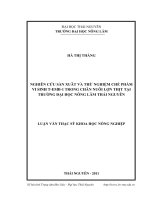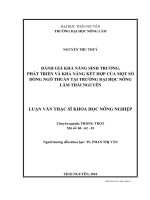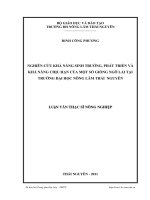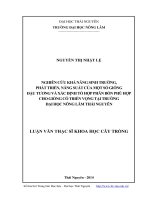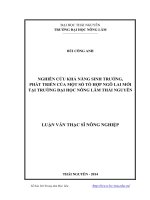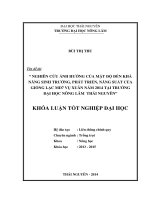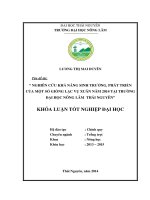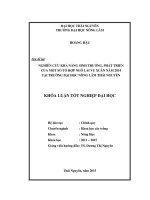Phát triển kĩ năng nghe cho sinh viên không chuyên tiếng Anh năm thứ nhất tại trường Đại học Nông Lâm Thái Nguyên thông qua các bài hát tiếng Anh
Bạn đang xem bản rút gọn của tài liệu. Xem và tải ngay bản đầy đủ của tài liệu tại đây (637.56 KB, 48 trang )
VIETNAM NATIONAL UNIVERSITY, HANOI
UNIVERSITY OF LANGUAGES AND INTERNATIONAL STUDIES
FACULTY OF POST-GRADUATE STUDIES
*********************
HÀ MINH TUẤN
DEVELOPING LISTENING SKILLS FOR THE FIRST YEAR NON
ENGLISH MAJOR STUDENTS AT THAI NGUYEN UNIVERSITY OF
AGRICULTURE AND FORESTRY THROUGH ENGLISH SONGS
Phát triển kĩ năng nghe cho sinh viên không chuyên tiếng Anh năm thứ nhất
tại trường Đại học Nông Lâm Thái Nguyên thông qua các bài hát tiếng Anh
M.A MINOR PRORAMME THESIS
FIELD: ENGLISH TEACHING METHODOLOGY
CODE: 60140111
Hanoi, 2014
VIETNAM NATIONAL UNIVERSITY, HANOI
UNIVERSITY OF LANGUAGES AND INTERNATIONAL STUDIES
FACULTY OF POST-GRADUATE STUDIES
*********************
HÀ MINH TUẤN
DEVELOPING LISTENING SKILLS FOR THE FIRST YEAR NON
ENGLISH MAJOR STUDENTS AT THAI NGUYEN UNIVERSITY OF
AGRICULTURE AND FORESTRY THROUGH ENGLISH SONGS
Phát triển kĩ năng nghe cho sinh viên không chuyên tiếng Anh năm thứ nhất
tại trường Đại học Nông Lâm Thái Nguyên thông qua các bài hát tiếng Anh
M.A MINOR PRORAMME THESIS
FIELD: ENGLISH TEACHING METHODOLOGY
CODE: 60140111
SUPERVISOR: NGUYỄN VĂN TRÀO, PhD.
Hanoi, 2014
i
DECLARATION
I hereby state that I, Hà Minh Tuấn– Thái Nguyên, being a candidate for the degree of
Master of Arts (TEFL), accept the requirements of the University relating to the retention
and use of Master‟s thesis deposited in the library.
In terms of the condition, I agree that the original of my thesis deposited in the library
should be accessible for the purposes of study and research, in accordance with the normal
conditions established by the librarians, for the care, loan, or reproduction of the thesis.
Hanoi, August 2014
Signature
Hà Minh Tuấn
ii
ACKNOWLEDGEMENTS
The completion of this study would have been impossible without the assistance of special
people.
First and foremost, I would like to acknowledge my indebtedness and gratitude to my
supervisor, Dr Nguyễn Văn Trào for his unfailing encouragement, constant support and
supervision during all stages of the study. His enthusiastic assistance, guidance, support,
and his wisdom greatly contributed to the fulfillment of my thesis.
I would like to say how thankful I am to the teachers and students at Thái Nguyên
university of Agriculture and Forestry for their tremendous supports in the collection of
data and information for my study.
Last but not least, I wish to express my acknowledgment to other individuals who have
indirectly contributed to the completion of this thesis.
To all these people I only hope that the achievement of my thesis will be favorable enough
to satisfy their expectation.
Thai Nguyen-2014
iii
ABSTRACT
This study aims to develop listening skills for the first year non English major
students at Thai Nguyen university of Agriculture and Forestry through English
songs. To fulfill this purpose, 240 first year non English major students were
selected from 4 classes. These participants were then asked to answer the
questionnaire, take part in some formal and informal discussion, make a face to face
interview with the researcher about the use of English songs in class.
The study was carried out over four-month course. Data was gathered and analyzed
through charts and tables. Results revealed that the use of English songs made a
rather significant improvement to the students‟ listening skills. Some
recommendations are finally presented based on research finding.
Key words: English songs, first year students, listening skills
iv
LIST OF TABLES AND CHARTS
1. LIST OF TABLES
Table 1:Teachers’ attitudes towards using songs
Table 2: Reasons why students listen to English songs
Table 3: Teachers’ opinions about advantages of using songs
Table 4: Teachers’ opinion about disadvantages of using songs
Table 5: Favorite activities while students listen to English songs
2. LIST OF CHARTS
Chart 1: Students’ attitude towards listening skill
Chart 2:Why listening skill difficult?
Chart 3: Students’ attitude towards using songs to develop listening skill
Chart 4: The situation of using songs to teach listening skill
Chart 5: Students’ opinion about using English songs in class
Chart 6: Students’ opinion about the disadvantages of using songs in classes.
v
TABLE OF CONTENTS
DECLARATION…………………………………
i
ACKNOWLEDGEMENTS……………………………………………………
ii
ABTRACT………………………………………………………………………
iii
LIST OF TABLES AND CHARTS……………………………………………
iv
CHAPTER 1: INTRODUCTION
1
1. Rationale of the study…………………………………………………
1
2. Aims of the study……………………………………………………….
3
3. Research questions……………………………………………………
4
4. Scope of the study………………………………………………………
4
5. Methods of the study …………………………………………………
4
6. The outline of the study…………………………………………………
4
CHAPTER 2: LITERATURE REVIEW
6
2.1 The definition of listening skill………………………………………………
7
2.2 Listening skill in foreign language teaching…………………………………
2.2.1 The importance of listening skill in foreign language teaching…………
8
2.2.2 The difficulties in learning listening skill…………………………………
9
2.2.3 Teaching listening skill according to CLT………………………………
10
2.3 . Teaching listening skills through English songs…………………………….
2.3.1 The importance of songs in developing listening skills…………………….
11
2.3.2 Using songs as motivator for students to learning listening skills……….
12
2.3.3 Tasks designed for listening texts…………………………………………….
14
2.4 Summary…………………………………………………………………………
15
CHAPTER 3: METHODOLOGY
16
3.1 The subjects…………………………………………………………………………
16
vi
3.2 Methods of data collection…………………………………………………
16
3.3 Procedures and methods of data analysis………………………………
16
CHAPTER 4: FINDINGS AND DISCUSSION
4.1 Findings
4.1.1 Students’ attitude towards listening skill……………………………………
17
4.1.2 The factors leading to students’ difficulty in listening skill…………………
17
4.1.3 Teachers’ attitudes towards using songs………………………………………
18
4.1.4 Students’ attitude towards using songs ………………………………………
19
4.1.5 The situation of using songs to teach listening skill…………………………
20
4.1.6 Reasons why students listen to English songs………………………………
21
4.1.7. Teachers’ opinion about advantages and disadvantages of using songs to
teach listening skill……………………………………………………………………
23
4.1.8 Students’ opinions about advantages and disadvantages of using songs to
learn English……………………………………………………………………………
25
4.1.9. Favorite activities while students are listening to English songs………….
26
4.2. Discussions of the findings………………………………………………………
28
4.3. Criteria of song selection………………………………………………………….
30
4.4 Some suggestions for teachers…………………………………………………….
31
4.5 Some suggested tasks when using songs to teach listening skill………………
32
4.6. Summary……………………………………………………………………………
33
CHAPTER 5: CONCLUSION
35
5.1 Summary of the study………………………………………………………………
35
5.2 Limitations and suggestions for further study………………………………….
36
REFERENCES
37
Appendixes………………………………………………………………
I
Sample songs
Sub questions
1
CHAPTER 1: INTRODUCTION
1. Rationale of the study
According to the theory of language acquisition, listening is the first mode for
children to acquire a language (Peterson, 1991; Wulandari, 2011). It provides a
foundation for language and cognitive development. Hunsaker (cited in Bozorgian,
2012) found that children achieve more than three quarters of what they learn in
school through listening. Research has shown that improvement in listening skill
positively affects other language skills: reading, writing and speaking (Bozorgian,
2012). Listening is also one of the most important language skills throughout
human‟s life. It makes up the largest part of human‟s communication. As found out
by different researchers (Wilt, Rankin, Feyton cited in Wulandari, 2011; Ralph &
Stevens, Rankin cited in Bozorgian, 2012), people spend 45% of their
communicating time to listen to each other, while they spend only 30% speaking,
16% reading and 9% writing. That finding confirmed what Rivers and Weaver had
found (as cited in Morley, 1991) that the time people spend listening is twice as
much as speaking, four times more than reading and five times as much as writing.
Listening can boost or impede the communication process and the mutual
understanding among people because it provides the input for “all aspects of
language and cognitive development” (Wulandari, 2011, p. 15).
Listening skill has salient importance in not only the first but also second
language learning (Bozorgian, 2012). Listening serves as the bridge to speaking and
writing because it is an activity to gain information. Moreover, listening
comprehension is of more importance when it comes as the crucial step in
understanding the foreign language to provide correct input for the two productive
skills. Peterson (1991: 106-107) emphasized that “no other type of language input is
as easy to process as spoken language, receive through listening”. Students can get
the most direct connection to the meaning of the new language through listening in
the early stages of their language study. By stressing the role of comprehensible
2
input, Krashen (as cited in Wulandari, 2011) agreed that listening lied at the heart of
language learning.
With that significance of listening in second language learning acquisition and
communication, I have understood the importance of developing English listening
skill for students at Thai Nguyen university of Agriculture and Forestry (TUAF).
Acknowledging the benefit that English brings in the current time, our
university (TUAF) has considered English to be one of the most important subjects
in the process of students‟ learning. Textbooks have been changed, teaching
methods have been changed and the hours of teaching English in class have been
much higher than ever before. All of these aim at developing the use of English for
students at our university. Moreover, in the context of being required to take a
graduated examination with A2 level, our students have to try their best to fulfill
this task. However, during the process of teaching English in the school and through
the result of the pre-training tests, I have realized that most of the first year students
get higher marks at grammar, writing, speaking and reading test, but listening test. I
have asked myself why my students get lower marks at listening tests; it could be
the structure of the school tests they used to take or it could be the teaching methods
that they used to get or it could be the lack of desire and motivation of listening
among the students. I have tried many methods in order to develop my students‟
listening skills, among which, I have found that English songs can help.
In addition, For many people whose first language is not English or they did not
learn English as a second language in school like in some European countries for
instance Belgium and Moldova (Ottilie, 2010; Xmarabout, 2010), their first
exposure to English may probably be through popular songs. Lynch (2005) points
out in his article that language teachers should use songs as part of their English
language teaching. Among the reasons given are that songs contain natural
language, are easily obtainable, and are natural and fun. He also states that a variety
of new vocabulary can be introduced as well as cultural aspects and even different
types of English accents. Songs can be selected to suit the needs and interests of
3
students. The lyrics of songs can be used in relating to situations of the world
around the students. Overall, he concludes that songs can offer an enjoyable
speaking, listening, vocabulary and language practice.
On the whole, songs are believed to be able to improve the current listening
teaching practice and develop students‟ listening comprehension.
Based on that rationale, the hypothesis for this study was formulated as
follows: Using English songs can develop listening comprehension skill for the first
year non English major students at TUAF in the academic year of 2013-2014.
2. Aims of the study
The main aim of the research is to help first year non English major students at
TUAF improve their listening ability through English songs. It first gives them an
overview of a suitable technique in learning listening and the significance of using
English songs to develop listening skill. Then, the thesis also aims at finding their
attitude towards the use of this technique in teaching listening skill, its benefits to
listening as well as English learning in general. Finally, it strives to suggest a
method to enhance listening skill and apply it in teaching and learning.
3. Research questions
This study aims at investigating the effects of using songs on improving
listening comprehension skill of first-year non English major students at TUAF, and
the impact it has on students‟ attitudes towards studying with this technique. It
attempts to address the following research questions:
(1) What are the students‟ attitudes towards listening skill?
(2) What are the students‟ attitudes towards English songs used in listening class?
4. Scope of the study
This study is limited to the first year non English major students at Thai
Nguyen University of Agriculture and Forestry (TUAF), and help develop students‟
listening skill through English songs.
4
5. Methods of the study
The study was designed to use English songs to develop students‟ listening
skills. To fulfill the above aims, qualitative and quantitative method was chosen for
the study. All comments, remarks, assumptions and conclusion of the study were
based on the questionnaire, data and analysis. Data collections for analysis in this
study were gained though the following methods: the first is through the survey
questionnaires (main method); the second is through a face to face interview (small
talks, discussion) with students
6. The outline of the study
The thesis consists of five chapters:
* Chapter 1 sets up theoretical background that is relevant to the purpose of the
study.
* Chapter 2 aims at providing a theoretical background to this study. The review of
issues most relevant to the focus of the study will be included: concepts of listening
comprehension, listening process, listening difficulties and the use of songs to help
the listeners solve the problem in listening skills
* Chapter 3 emphasizes the subjects of the study, method of data collection, and
procedures and methods of data analysis.
* Chapter 4 presents the analysis of findings and discussion
* Chapter 5 summarizes the key issues in the study, points out the limitations, and
provides some suggestions for further research.
5
CHAPTER 2: LITERATURE REVIEW
This chapter is aimed at providing a theoretical background to this study. The
review of issues most relevant to the focus of the study will be included: concepts of
listening comprehension, listening process, listening difficulties and the use of songs to
help the listeners solve the problem in listening skills.
During the process of teaching and learning English, applying a suitable
method in teaching requires both teacher and learners have long lasting cooperation
and especially, the teacher should have high creativeness in giving his own
knowledge to the students. That “develop listening skills for the first year non
English major students through English songs” is a method in developing listening
skills to the students. The chosen English songs are one of the materials in teaching
listening skill because music can help learners remember quickly and create a long
lasting effectiveness. When information is spoken along with the rhythms, learners
will remember better. It is true that the rhythms and lyrics in music have an
enormous influence in helping learners save information.
Songs also give new insights into the target culture. They are the means
through which cultural themes are presented effectively. Since they provide
authentic texts, they are motivating. Prosodic features of the language such as stress,
rhythm, intonation are presented through songs, thus through using them the
language which is cut up into a series of structural points becomes a whole again.
There are many advantages of using songs in the classroom. Through using
contemporary popular songs, which are already familiar to teenagers, the teacher
can meet the challenges of the teenage needs in the classroom. Since songs are
highly memorable and motivating, in many forms they may constitute a powerful
subculture with their own rituals. Furthermore, through using traditional folk songs
the base of the learners‟ knowledge of the target culture can be broadened.
Correctly chosen, traditional folk songs have the dual motivating attack of pretty
tunes and interesting stories, plus for many students- the added ingredient of novelty
6
(Hill, 1999:29). Most songs, especially folk songs, follow a regularly repeated verse
form, with rhyme, and have a series of other discourse features, which make them
easy to follow.
2.1. The definition of listening skill
Listening is one of the fundamental language skills, and crucial in the
development of the second language competence so there are many definitions of
listening which present different views of scholars towards the concept.
Listening is the ability to identify and understand what others are saying.
According to Anderson and Lynch (1988), listening is really a receptive skill along
side with reading skills and the role of listeners is no longer passive but active. Rost
(1994) says that “listening is referred to a complex process that enables us to
understand spoken language.” It is an invisible mental process, so it is very difficult
to describe. This involves understanding the speaker‟s accent or pronunciation, his
grammar and his vocabulary, and grasping his meaning (Howatt and Dakin, 1974).
Rost defines listening consists of:
Discriminating between sounds
Recognizing words
Identifying grammatical groups of words
Identifying “pragmatic units” – expressions and sets of utterances which
function as whole units to create meaning
Connecting linguistic cues to paralinguistic cues (intonation, stress) and to
nonlinguistic cues (gestures) in order to construct meaning
Using background knowledge and context to predict and then to confirm
meaning
Recalling important words and ideas
(Rost, cited in Rosová, 2007)
From the points of view above, it is obvious that an able listener is capable of
integrating all these component skills.
7
Underwood (1989) also says that “listening is the ability of paying to and
trying to get meaning from something we hear”. She explains that to listen
successfully to spoken language, we need to be able to work out what speakers
mean when they use particular words in particular ways on particular occasions, and
not simply to understand the words themselves. But listening is different from
hearing. Whilst hearing can be thought of as a passive condition, listening is always
an active process (Underwood, 1989). Actually, hearing is possible to hear sounds
without consciously engaging in the process. In contrast, in listening, the brain does
not automatically translate the words into message they are conveying. It involves
much more than assigning labels to sounds or words.
2.2 Listening skill in foreign language teaching
2.2.1 The importance of listening skill in foreign language teaching
It cannot be denied that we spend a large portion of our time listening because
it is a key element of the verbal communication. It has been estimated that adults
spend almost half their communication time listening, and students may receive as
much as 90% of their in – school information through listening to instructors or to
one another. However, in the past, reading and grammar skills were paid much
attention to while speaking and listening skills were taken for granted. As a result,
language learners did not recognize its importance in developing language skills.
Rost (1994) emphasizes the importance of listening for several reasons below:
Listening is vital in the language classroom because it provides input for the
learner. Without understandable input at the right level, any learning simply cannot
begin.
Spoken language provides a means of interaction for the learner. Since the
learners must interact to achieve understanding, access to speakers of the language
is essential. Moreover, learners‟ failure to understand the language they hear is
impetus, not an obstacle, to interaction and learning.
Authentic spoken language presents a challenge for the learner to attempt to
understand language as it is actually used by native speakers.
8
Listening exercises provide teachers with a means for drawing learners‟
attention to new forms (vocabulary, grammar, interaction patterns) in the language.
Moreover, listening is also an important condition for developing other
skills, especially speaking skill as Doff (1988) suggests that we cannot develop
speaking skill unless we develop listening skill. Indeed if we want to speak well, we
firstly must listen to what others say and understand them clearly.
To sum up, listening skill has taken a very important part in learning English.
It is the most communicative and practiced skill that needs to be developed as much
as possible.
2.2.2 The difficulties in learning listening skill
There are several reasons why students find listening to foreign languages
and English in particular, so difficult:
* spelling and pronunciation of English differ a lot: “Many learners of English fail
to recognize the spoken forms of words that they „know‟ very well in print or
writing.” (Rixon 1990 p. 38)
* connected speech - students are able to recognize the words in isolation,
connected speech poses a big problem though (factors of assimilation, weakening of
sounds etc. come into play).
* rhythmic pattern of English, rules for putting stress and intonation (while in
Vietnamese language there is no stress on words because all words are root words
or single words, in English it can also be on the first or the second or the third or the
last)
* the „same‟ sounds (usually vowels) can be pronounced in several different ways
(break x weak x fear etc.)
* use of colloquial vocabulary in informal dialogues; grammar deviations; broken
syntax
* the pace of the recording or speech is the same for everybody - we can not replay
it anytime we want; in real-life listening we are usually exposed to the text only
once: “Written discourse is fixed and stable so the reading can be done at whatever
9
time, speed and level of thoroughness the individual reader wishes. Spoken text in
contrast is fleeting, and moves on in real time. The listener - though he or she may
occasionally interrupt to request clarification must in general follow what is said at
the speed set by the speaker.” (Ur 2004, p 160)
* other factors such as poor acoustic conditions or noise can make the listening
activity even more stressful for the learners
To solve these problems, teachers should make the lessons more interesting to
motivate the students to listen by some interesting activities in class. One of the
activities is to listen to English songs. In relation to the students at TUAF- Foreign
Language Center who still feel it very difficult to understand the meaning of the
material after playing the tape for twice or three times in class. Songs seem to be the
suitable choice because the students will be stimulated and not be panic or worry
when they are learning listening.
2.2.3 Teaching listening skill according to CLT
Communicative Language Teaching (CLT), derived from the late 1970s and
early 1980s, can be said to be the product of educators and linguists who had grown
dissatisfied with the audio-lingual and grammar-translation methods of foreign
language instruction. It can be understood as a set of principles about the goals of
language teaching, how learners learn a language, the kinds of classroom activities
that best facilitate learning, and the roles of teachers and learners in the classroom.
According to Richards (2002), “CLT was an attempt to operationalize the concept
of communicative competence and to apply it across all levels of language program
design, from theory, to syllabus design, to teaching techniques.” In other words,
CLT makes use of real-life situations that necessitate communication. The Teacher
sets up a situation that students are likely to encounter in real life. As a part of
communication, listening can be taught in a communicative way.
According to Rost (1990), listening is given a new role in language learning in
CLT: communicative approach views listening as an interactive functional basic
mode of communication on rather than a skill to be learned and tested CLT
10
emphasizes the use of extensive listening to material taken from “authentic” L1
situations where learners are expected to select the language they need to use in
order to perform language tasks.
It can be said that listening plays an important role in CLT. It can enable the
listeners to select a function of language from the presented listening model and to
apply it in communication activities. Besides, it could stimulate communication by
creating the need for social interaction through simulation of real-life situations.
CLT regards listening as a procedure in language learning not as a target of learning
by itself.
2.3 Teaching listening skills through English songs
2.3.1 The importance of songs in developing listening skills
No one can deny that music has played a very important part in our life. Every
one likes music. It accompanies with us very time we feel happy or sad. Music is at
everywhere, every time we need it: “when we exercise, when we work, when we
play, when we worship and even when we die, music is there to reinforce or alter
every mood and emotion” (Lynch, 2005 p.37). Studies have shown that music can
improve concentration, improve memory, bring a sense of community to a group,
motivate learning, relax people who are overwhelmed or stressed, make learning
fun, help people absorb material.
Due to its great value, music and songs have been taken into consideration as a
method to teach language as Medina (1993) says “it is currently a common practice
to use songs in the classroom to support second language acquisition” because
music can stimulate and motivate students to learn a new language. It is really a
language package that bundles culture, vocabulary, listening, grammar and a host of
other language skills in just a few rhymes (Inggris, 2008).
In the words of Lynch (2005), “songs are useful in the language learning
classroom”. Therefore, he points out 9 reasons why foreign language teachers
should use songs to teach EFL:
o Songs almost always contain authentic, natural language.
11
o A variety of new vocabulary can be introduced to students through songs.
o Songs are usually very easily obtainable.
o Songs can be selected to suit the needs and interests of the students.
o Grammar and cultural aspects can be introduced through songs.
o Time length is easy controlled.
o Students can be experience a wide range of accents.
o Song lyrics can be used in relating to situations of the world around us.
o Students think songs are natural and fun.
(Lynch, 2005)
To share the same view, Davanellos (1999) says that “songs are not only fun,
they have a serious purpose for language learning”, he also suggests several good
reasons of using songs for teaching purposes. One of the reasons the students are
interested in studying is that they feel motivated as “enjoyable learning has to be
more effective than teacher-centred procedures” (Davanellos, 1999).
To sum up, songs not only play an important part in our life but are a useful
tool to learn in a foreign language classroom. So teachers of foreign language
should make use of them to make the lessons more interesting and stimulate
students to learn.
2.3.2 Using songs as motivator for students to learning listening skills
Songs can be used to show our emotions, it makes us happy, helps us ease the
pain in the best way. Besides, songs can be utilized in foreign language teaching for
many purposes. According to Eken (1996), songs can be used:
To present a topic, a language point, lexis, etc.
To practice a language point, lexis, etc.
To focus on common learner errors in more direct way.
To encourage extensive and intensive listening.
To stimulate discussion of attitudes and feelings.
To encourage creativity and use of imagination.
To provide a relaxed classroom atmosphere.
12
To bring variety and fun to learning.
It is proved that what you can do with a text you can do with a song. They can
also form the basis for many lessons (Futonge,2005 cited in Inggris, 2008). So
Lynch (2005) suggests three factors that songs can be made use of in a foreign
language classroom: the use of new vocabulary, idioms and expressions;
pronunciation and accent of the singer; and use of new grammar and structure. To
share the same point of view, Ur (1986) points out that songs are taught for a variety
of purposes: “for the sake of vocabulary or structures they contain, to get students to
produce oral English by singing them; as an aspect of English-language culture; for
fun.” Moreover, in the words of Saricoban and Metin (2000), songs can develop the
four language skills (reading, writing, listening, and speaking).
There are two processes involved in listening: bottom-up process and top-
down process. Cullen (1999) says that the first is bottom-up processing where the
listener builds up the sounds into words, sentences and meaning. The second is top-
down processing where the listener uses background knowledge to understand the
meaning of a message. Practicing both of these processes is essential for developing
comprehension. Songs can be used to utilize these two processes. Also, researchers
have shown that music can change the brain waves and make the brain more
receptive to learning. Music connects the functions of the right and left hemispheres
of the brain so that they work together and makes learning quick and easy.
Krashen (1982) explains that optimal learning will occur if the affective filter
must be weak. According to his Affective Filter Hypothesis, a weak filter means
that a positive attitude towards learning is present. If the affective filter is strong,
the learner will not seek language input, and in turn will not be open to language
acquisition. The practical application of this hypothesis is that teachers must
provide a positive atmosphere conducive to language learning. Songs are one
method for achieving a weak affective filter and promoting language learning.
13
In conclusion, songs are one of the best methods to teach and motivate
students to learn listening skill. So teachers should take advantages of songs to
stimulate and help students improve their listening skill.
2.3.3 Tasks designed for listening texts
There are various kinds of listening tasks. According to Ur (1984), possible and
applicable listening tasks should be:
- Dictation exercise:
This is common listening exercise which is usually practices in the earlier years of
school education. It requires students an integrative knowledge of the phonological,
syntactic and semantic systems of a language. To do this task, teacher gives students
handout, omitting some sentences of the text, then plays the tape and asks students
to listen to the text and write the missing sentences down.
- Ticking off items:
Learners tick beside the items: Learners tick beside the items that they hear in the
listening
- True/False:
Identify whether the statement is true or false based on the listening.
- Detecting mistakes:
Some fact is mentioned with intentional mistakes for students to point out.
- Gap-filling:
Students are given a passage with several gaps in it, they have to listen and fill in
the missing words in the gaps.
- Pictures:
One picture or a series of pictures may be used. Sts are then asked to identify
pictures or components as they are referred to, either naming or ordering them in the
order in which they are mentioned
- Answering questions:
Based on the content of the listening, students are required to give longer and full
answer to the questions
14
2.4 Summary
This chapter has presented the relevant literature, which has helped to form the
theoretical and conceptual framework for the study.
Firstly, a number of concepts about listening comprehension are given: much
agreement is that listening has been considered as a vital role in communicative
language teaching.
Secondly, the importance of listening in second language learning and some
problems that students may cope with when they learn this skill are discussed.
Lastly, there are some discussions about the advantages of songs and it should
be taken into consideration to be applied in teaching and learning foreign language.
15
CHAPTER 3: METHODOLOGY
3.1 The subjects
The subjects of the study are the first year non English major students. Most of
the students come from the mountainous provinces of Vietnam. The chance for
them to learn English is not as good as those who live in big cities. Most of them do
not seem to concern about the importance of learning English because they focused
on the subjects they have to take when taking part in a university entrance
examination. When they enter the university, they fear English, they consider it a
difficult subject to learn. They are bored and passive in learning English. For most
of the students, is only understood as an obligatory subject in university curriculum.
3.2 Methods of data collection
The research adopted questionnaire and interview as means of data collection.
In addition, formal and informal discussions and small talks with teachers and
students to collect more data for this study were also conducted.
3.3 Procedures and methods of data analysis
The aim of the questionnaires was to collect data relating students‟ attitudes
towards listening skill, the reasons that caused students‟ difficulties in learning
listening skill, teachers and students‟ attitudes towards English songs and using
songs in teaching and learning listening skill, and the situation of using songs to
teach listening skill at TUAF. Basing on categories established, data was then
analyzed by using descriptive statistics (percentage) and qualitative statistics
(informal discussions, interview). Pie chart, graphs and tables were mainly
employed to analyze and compare figures. The information was gathered from two
questionnaires were presented and analyzed as in chapter 4, finding and discus
16
CHAPTER 4: FINDINGS AND DISCUSSIONS
4.1 Findings
4.1.1 Students’ attitudes towards listening skill
Most of the students agreed that listening skill played a very important role in
second language learning but it was the most difficult skill to be reached. As can be
seen from Chart 1, a larger number of students (86%) thought that listening skill
was very difficult, 10% of them considered listening skill was difficult and 4% of
them said that it was not very difficult. 4% of the students who said listening skill
was not difficult much had higher English level than the others. They were good at
basic English at high-school level because they came from specialized schools or
school in urban areas.
Students' attitude towards
listening skill
4%
10%
86%
Very difficult
difficult
as easy as other
skills
Chart 1: Students’ attitudes towards listening skill
4.1.2 The factors leading to students’ difficulty in listening skill
There are many reasons causing difficulties to students‟ listening skill, but most
of them admitted that they had few chances to listen right from the secondary and
high school level. Most of the teachers have found it easier to teach grammar and
other skills, but listening. Another reason was that they could not keep up with the
speaker‟s speed and were often left behind. As a result, they could hardly
understood what the speaker had said. Besides, limited vocabulary is another
17
important cause that makes listening difficult for the students.Unfamiliar to
speaker‟s accent and unfamiliar topics are also the main reason preventing them
from understanding the whole text. The chart below shows The reasons cause
students‟ difficulty in listening skill (Chart 2)
Why listening skill difficult?
20%
31%
44%
5%
Speaker's speed
Vocabulary
Few chance
Unfamilar topics
Chart 2: Why listening skill difficult?
4.1.3 Teachers’ attitudes towards using songs
To carry out the study, the researcher also got teachers‟ opinion about using
songs to teach listening skill mainly from the questionnaire and interview. Firstly,
when being asked about their attitudes about English songs, whether they liked or
disliked. All of them said that they (100%) liked listening to English songs.
However, when asked if they had ever used English songs to start at the beginning
and during a lesson in order to get students‟ desire from the lesson, some of them
said yes and others of them said they had never tried before. They said that they had
no ability to perform an English song, even though there were some in textbook.
They added that it is really a good idea to make use of English songs to teach
listening skill. However, a few of them stated that it is not still an effective way to
teach listening skill because songs contain sounds, noise and theme music which
cause students a lot of difficulties in listening and recognizing the sounds. The

